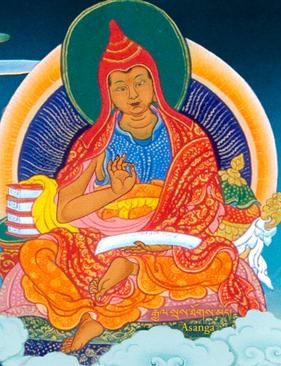Asanga: Difference between revisions
Jump to navigation
Jump to search
No edit summary |
|||
| (7 intermediate revisions by 2 users not shown) | |||
| Line 1: | Line 1: | ||
[[Image:Asanga.JPG|frame|Asanga]] | [[Image:Asanga.JPG|frame|Asanga]] | ||
'''Asanga''' (Skt. ''Asaṅga'' | '''Asanga''' (Skt. ''Asaṅga''; Tib. [[ཐོགས་མེད་]], ''Tokmé'', [[Wyl.]] ''thogs med'') — one of the most famous Indian saints; he lived in the fourth century and was the elder brother of [[Vasubandhu]]. He received teachings from [[Maitreya]] and transcribed them as the ‘[[Five Treatises of Maitreya]]’. Together with Asanga's own commentaries, these texts became the basis for the philosophical schools known as [[Yogachara]], or [[Chittamatra]]. | ||
== | ==Writings== | ||
*[[ | *''[[Compendium of Abhidharma]]'' | ||
*[[ | *''Five Treatises of Maitreya'' | ||
*[[ | *''[[Summary of the Mahayana]]'' | ||
*''[[Yogacarabhumi]]'', which includes the ''[[Bodhisattva Bhumis]]'' | |||
==Further Reading== | ==Further Reading== | ||
*Lobsang N. Tsonawa, ''Indian Buddhist Pandits from The Jewel Garland of Buddhist History'', Dharamsala: Library of Tibetan Works and Archives, 1985. | *Lobsang N. Tsonawa, ''Indian Buddhist Pandits from The Jewel Garland of Buddhist History'', Dharamsala: Library of Tibetan Works and Archives, 1985. | ||
*[[Sogyal Rinpoche]], ''[[The Tibetan Book of Living and Dying]]'', pages 125-126. | *[[Sogyal Rinpoche]], ''[[The Tibetan Book of Living and Dying]]'', pages 125-126. | ||
==Internal Links== | |||
*[[Vast Conduct]] | |||
==External Links== | ==External Links== | ||
| Line 16: | Line 20: | ||
[[Category:Indian Masters]] | [[Category:Indian Masters]] | ||
[[Category:Seventeen Nalanda Masters]] | [[Category:Seventeen Nalanda Masters]] | ||
[[Category:Chittamatra]] | |||
Latest revision as of 22:13, 16 February 2021

Asanga (Skt. Asaṅga; Tib. ཐོགས་མེད་, Tokmé, Wyl. thogs med) — one of the most famous Indian saints; he lived in the fourth century and was the elder brother of Vasubandhu. He received teachings from Maitreya and transcribed them as the ‘Five Treatises of Maitreya’. Together with Asanga's own commentaries, these texts became the basis for the philosophical schools known as Yogachara, or Chittamatra.
Writings
- Compendium of Abhidharma
- Five Treatises of Maitreya
- Summary of the Mahayana
- Yogacarabhumi, which includes the Bodhisattva Bhumis
Further Reading
- Lobsang N. Tsonawa, Indian Buddhist Pandits from The Jewel Garland of Buddhist History, Dharamsala: Library of Tibetan Works and Archives, 1985.
- Sogyal Rinpoche, The Tibetan Book of Living and Dying, pages 125-126.